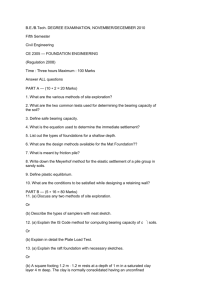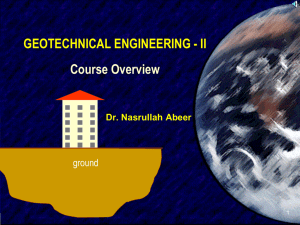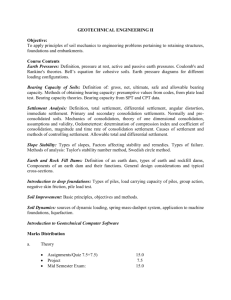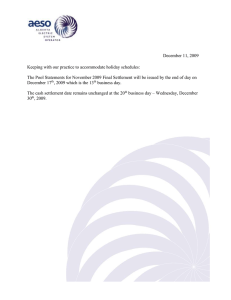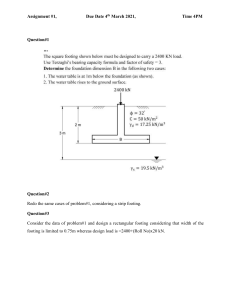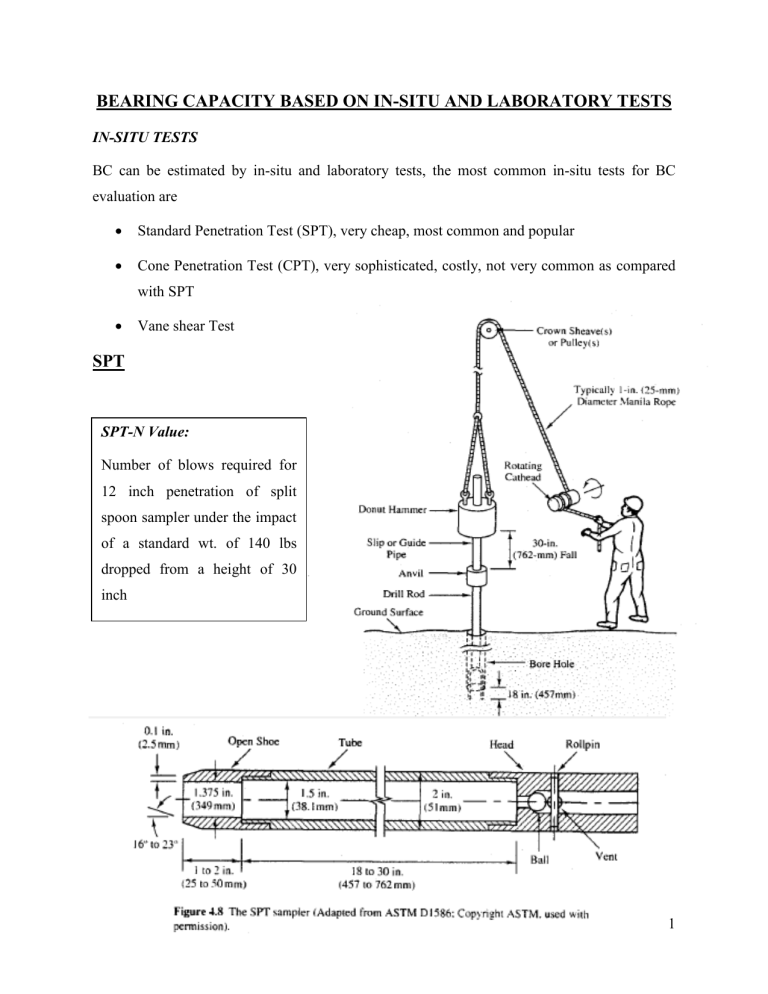
BEARING CAPACITY BASED ON IN-SITU AND LABORATORY TESTS IN-SITU TESTS BC can be estimated by in-situ and laboratory tests, the most common in-situ tests for BC evaluation are Standard Penetration Test (SPT), very cheap, most common and popular Cone Penetration Test (CPT), very sophisticated, costly, not very common as compared with SPT Vane shear Test SPT SPT-N Value: Number of blows required for 12 inch penetration of split spoon sampler under the impact of a standard wt. of 140 lbs dropped from a height of 30 inch 1 It consists of penetrating a sampler known as split spoon sampler by dropping a standard weight of 140 lbs by 30 inch height. The sampler is penetrating by 18 inches total and for each 6 inches; the number of blows required for each of the penetration are counted separately. The number of blows for first 6 inches is ignored and the total numbers of blows for next two 6 inch penetration (total 12 inch) are taken and known as SPT-N value. (e.g. if the respective blow count for three successive 6 inch penetration are 8, 9, 10 then SPT-N value is 19.) As a part of test, the representative but disturbed soil sample is procured at the test depth for laboratory testing. SPT is generally performed at every 1 m interval up to 15~20 m and then interval may be increased to 1.5-2 m. If SPT is performed below GWT, the SPT-N values is overestimated and a correction to measured N is (dilatancy correction) applied if SPT-N value exceeds 15 Ncorr. = 15 + 0.5(Nmeasured -15) The SPT is more reliable for granular soils as compared with fine grained soils. In case of gravels, a 60o cone is used in stead of split spoon samples If SPT is performed below GWT, sand boiling causes disturbance leading to erroneous SPT-N values. The borehole casing should be filled with water all the time to avoid sand boiling in case of light percussion technique. The SPT-N value has the following correlation with different parameters. 2 GRANULAR SOILS Very Loose Loose Medium Dense Very Dense 0 – 0.15 0.15 – 0.35 0.35 – 0.65 0.65 – 0.85 0.85 – 1.00 0–4 5 – 10 11 – 30 31 – 50 51 – UP Approximate angle of internal friction, degree) 25 – 28 28 – 30 30 – 35 35 – 40 38 – 43 Approximate range of moist unit weight, (pcf) 70 – 100 90 – 115 110 – 130 110 – 140 130 – 150 60 55 – 65 60 – 70 65 – 85 75 Description Relative density, Dr Standard value, N Penetration Test Submerged unit weight, sub COHESIVE SOILS Description Unconfined strength, qu (tsf) Standard value, N compressive Penetration Test Approx. range of saturated unit weight, sat (pcf) Very Soft Soft Firm Stiff Very Stiff Hard 0 – 0.25 0.25 – 0.5 0.5 – 1.0 1.0 – 2.0 2.0 – 4.0 4.0 – UP 0–2 3–4 5–8 9 – 16 17 – 32 33 – UP 100 – 120 100 – 130 120 – 140 130+ 3 1. Bearing Capacity from SPT a. Terzaghi & Peck (1948) Method Terzaghi & Peck (1948) were first to propose a correlation between SPT-N value and allowable pressure for a settlement of 25 mm (1 inch). The estimation of qa is considered to be very conservative and is generally not used by current practitioners. The equation is as inder: B 1 q a 720N 3 K d Rw 2B 2 N>3 where qa = net allowable bearing pressure in psf for 1 inch settlement and B in ft. B 0.305 q a 34.5N 3 K d Rw , 2B 2 or K d (1 0.33 D ) 1.33 , B qa in kPa, B in m (for R’w see Fig. 1) This equation can be modified for calculation of settlement for any given pressure 2 2.9 B s qC K N 3 B 0.305 d w s in mm, B in m and q in kPa Cd = 1 for D/B = 0 Cd = 0.75 for D/B = 1 Kw = 1 for Dw > B Kw = 2.0 for Dw = 0 b. Meyerhof (1956) method: (SI units) qa = 12 N Kd for B1.2 m (Fps units) qa = (SI units) B 0.3 qa= 8 N Kd B (Fps units) N B 1 qa = Kd 6 B N Kd 4 for B < 4 ft 2 for B > 1.2 m 2 for B > 4 ft 4 Where, qa = allowable bearing pressure for a maximum settlement of 25 mm or 1-inch, kPa or ksf. N = SPT resistance in blows/300 mm = statistical average value for the footing influence zone of about 0.5B above footing base to at least 2B below. B = footing width in meters or feet. Kd = depth factor = (1 0.33 D ) 1.33 B sactual For any settlement, s qactual qa For s = 25 mm, the above equations (in SI units) can be modified to determine settlement under the known contact pressure or vice versa as below: sactual 2 C d qactual N for B 1.2 m 2 sactual 3.12 B C d qactual N B 0.3 Where C d 1 Kd 1 D 1 0.33 B for B > 1.2 m 0.75 and 1.0 c. Meyerhof method modified by Bowles (1977): (SI units) qa = 20 N Kd for B1.2 m (Fps units) qa = (SI units) B 0.3 qa.= 12.5 N Kd B for B > 1.2 m (Fps units) N B 1 qa = Kd 4 B for B > 4 ft N Kd 2.5 for B < 4 ft 2 2 Where, qa = allowable bearing pressure for a maximum settlement of 25 mm or 1-inch, kPa or ksf. N = SPT resistance in blows/300 mm = statistical average value for the footing influence zone of about 0.5B above footing base to at least 2B below. 5 B = footing width in meters or feet. Kd = depth factor = (1 0.33 D ) 1.33 B sactual For any settlement, s qactual qa For s = 25 mm, the above equations (in SI units) can be modified to determine settlement under the known contact pressure or vice versa as below: sactual 1.25 C d qactual N for B 1.2 m 2 sactual 2 B C d qactual N B 0.3 Where C d 1 Kd 1 D 1 0.33 B for B > 1.2 m 0.75 and 1.0 d. Teng (1962) Relations based on shear failure criterion For strip footing: qult 3BN 2 Rw 5(100 N 2 ) DRw (Fps units) The above equation may be modified for qs (FS=3) in SI units qs 0.157 BN 2 Rw 0.262(100 N 2 ) DRw (SI units) For square footing: qult 2BN 2 Rw 6(100 N 2 ) DRw (Fps units) The above equation may be modified for qs (FS=3) in SI units qs 0.105BN 2 Rw 0.314(100 N 2 ) DRw (SI units) Where, qs = net safe bearing capacity w.r.t. shear failure alone for FOS of 3 in psf or kPa B = footing width in ft or meters N = SPT resistance in blows/300 mm D = footing depth in ft or meters; if D > B use D = B for computation 6 Rw & R'w = water table reduction factor B Footing Water Table Df da db Water Table B (a) da R w = 1 - 0.5 Df R' w 1.0 1.0 0.9 0.9 0.8 0.8 Reduction factor, 0.7 R' w 0.6 Reduction factor, 0.7 Rw 0.6 0.5 0 0.2 0.4 0.6 0.8 1.0 d a /D f 0.5 = 0.5 + 0.5 db B 0 0.2 0.4 0.6 0.8 1.0 d b /B (c) (b) Fig. 1: Correction factors for position of water level: (a) depth of water level with respect to dimension of footing; (b) water level above base of footing; (c) water level below base of footing. e. Parry (1977) Relation based on shear failure criterion For cohesionless soils only qult = 30 N (kPa) (D B) N = average SPT value at a depth about 0.75B below the proposed base of the footing. 7 2. Bearing Capacity using CPT (i) Meyerhof (1956) For a maximum settlement of 25 mm; for foundations (strip or square) on dry sands: qa= 3.6 qc kN/m2 qc/30 kg/cm2 for B 1.2 m qa= 2.1 qc (1 + 1/B)2 kN/m2 qc/50 (1 + 1/B)2 kg/cm2 for B > 1.2 m For any value of B, an approximate formula is: qa= 2.7 qc kN/m2 = qc/40 kg/cm2 Where, qa = allowable pressure for 25 mm B = footing width in meters. qc = CPT cone resistance in kPa. Notes: above equations are based on the approximate rule that N =qc/4 (in kg/cm2). qa is halved if the sand within the stresses zone is submerged. For rafts and pier foundations, double the qa values determined above. (ii) Schmertmann (1978) The bearing capacity factors for use in Terzaghi's bearing capacity equation can be estimated as: 0.8 Nq 0.8 N qc D/B 1.5. Where qc is average cone resistance over depth interval from B/2 above to 1.1B below footing base. For Cohesionless Soils Strip: qult 28 0.0052(300 qc )1.5 in kg/cm 2 or tons/ft2 Square: qult 48 0.009(300 qc )1.5 in kg/cm 2 or tons/ft2 For Cohesive Soils Strip: qult 2 0.28qc in kg/cm 2 or tons/ft2 Square qult 5 0.34qc in kg/cm 2 or tons/ft2 8 3. Bearing Capacity Using Vane Shear Test (VST) qult 5 u (1 0.2 D B)(1 0.2 B L) v Where, = strength reduction factor u = undrained shear strength = T 3.6 D 3 T = measured torque D = blade diameter of vane v = total overburden pressure at foundation level. 1.2 1.0 0.8 0.6 0.4 0 20 40 60 PI , (%) 80 100 120 Correction factor for the field vane test as a function of PI, (after Bjerrum, 1972, and Ladd, et al., 1977). 9 4. BEARING CAPACITY FROM PLATE LOAD TEST Dead Weight Loading Frame Pit Three Settlement Dial Gauges Spaced Rigid Steel Plate of Square Shape o at 120 apart approx. Hydraulic Jack with Loading Cell Schematic sketch showing load-test arrangement For details of equipment and testing procedure, refer to ASTM D 1195 The load is applied in increments of 25% of the proposed design load. Increments are added till the final load is 150 to 200% of the proposed design load or to the failure of the soil underneath the plate. Each increment of load is maintained until the settlement is ceased, however the final applied load is maintained for not less than 24 hours. Settlement dial readings are recorded for each load increment after 5, 10, 15, 30, 60 minutes and every 1 hour interval thereafter to the first 6 hours and at least once every 12 hours thereafter. Load Pu P u = Ultimate Load 1 Settlement 2 Typical load-settlement plots of a load test 10 Data Reduction and Analysis The ultimate load can be obtained: directly from the curve (1) or using two tangents method, curve (2). then qult, foundation = qult, load test for clay B q ult q plate foundation B plate for sand Settlement of prototype footing (Terzaghi and Peck, 1948): s f sp ( Sf Bf Bp ) Bf Sp B p for clays, and 2 2 B p 1 for sands B 1 f For a square plate of 1 ft 1 ft size 2B f s f sp B 1 f 2 for sands Where sf & sp = settlements of prototype foundation and a square plate of 1 ft 1 ft size respectively. Bf (or B) & Bp = widths of the prototype foundation and plate respectively. Above equations are for surface footings i.e. D = 0 To estimate the settlement of footings placed at depth D apply the depth correction factor using Fox's (1948) curves. How to Obtain BC from Plate Load Test Results The permissible settlement Sf for a prototype foundation should be known. Normally settlement of 2.5 cm (1 inch) is recommended. In above equations, the values of Sf and Bp are therefore known. The unknown are Sp and Bf. The value of Sp for any assumed size Bf may be found out from the above equations and then using the plate load settlement curve, the value of the bearing pressure corresponding to the computed value of Sp is found out. 11 The bearing pressure is the allowable bearing pressure for a given permissible settlement Sf. Limitation of the Plate Load Test 1. Since plate load test is of short duration, it will not give consolidation settlement. If the underlying soil is sandy in nature immediate settlement may be taken as the total settlement. If the soil is clayey type, the immediate settlement is only a fraction of the total settlement. Load tests, therefore, do not have much significance in clayey soils to determine allowable pressure on the basis of settlement criterion. 2. Plate load tests should be used with caution and the present practice is not to rely too much on this test. If the soil is not homogeneous to a great depth, plate load tests give very misleading results. Soil-1, stiff clay Soil-2, soft clay Assume two layers of soil. The top layer is stiff clay where as the bottom layer is soft clay. The load test conducted near the surface of the ground measures the characteristics of stiff clay but does not indicate the nature of the soft clay soil which is below. The actual foundation of a building, however, has a bulb of pressure which extends to a great depth into the poor soil which is highly compressible. Whereas the soil tested by the plate load test is very good leading to unsafe design. Plate load test is, therefore, not at all 12 recommended on soils, which are not homogeneous at least to a depth equal to 1.5 to 2 times the width of the prototype foundation. 3. Plate load tests should not be relied on to determine the ultimate B.C of sandy soils as the scale (size) effect gives very misleading results. However, when the tests are carried on clay soils, the ultimate B.C as determined by the test may be taken as equal to that of the foundation since the bearing of clay is essentially independent of the footing size 5. BY LABORATORY UNCONFINED COMPRESSION TEST The B.C of a cohesive soil can also be evaluated from the unconfined compressive test on cohesive soils. The failure axial stress in case of unconfined compression test is termed as unconfined compressive stress which is equal to: qu = 2C and C = qu/2 and =0 (for undrained condition) By Terzaghi’s equation, the BC of cohesive soils for =0 case is qun = CNc Nc = 5.7 or approximately 6 qun = 6C for FS=3 qns = 2C = qu Therefore, the net safe bearing capacity (qns) of cohesive soil can be taken approximately equal to unconfined compression strength of cohesive soil. 6. BC BY BUILDING CODES: In many countries/cities, the local building code stipulates values of allowable soil pressure to use when designing foundations. These values are usually based on years of experience, although in some cases they are simply used from the building construction handbooks. 13 These arbitrary values of soil pressure are termed as Presumptive Bearing Pressures. The presumptive pressures are generally based on a visual soil classification. Following table summaries the Presumptive Bearing Pressures from the International Building Code. Table: Presumptive Bearing Pressures from the International Building Code (IBC, 1997) Soil or Rock Classification Allowable Bearing Pressure, qa (kPa) (lbs/ft2) Crystalline Bedrock 600 12,000 Sedimentary or Foliated Rocks 300 6,000 Sandy gravel, or gravel (GW, GP) 250 5,000 Sand, silty Sand, clayey sand, silty gravel, 150 3,000 100 2,000 0 0 clayey gravel, (SW, SP, SM, SC, GM and GC) Clay, sandy clay, silty clay, or clayey silt, (CL, ML, MH, CH) Mud, organic silt, organic clay, peat or unprepared fill 14
